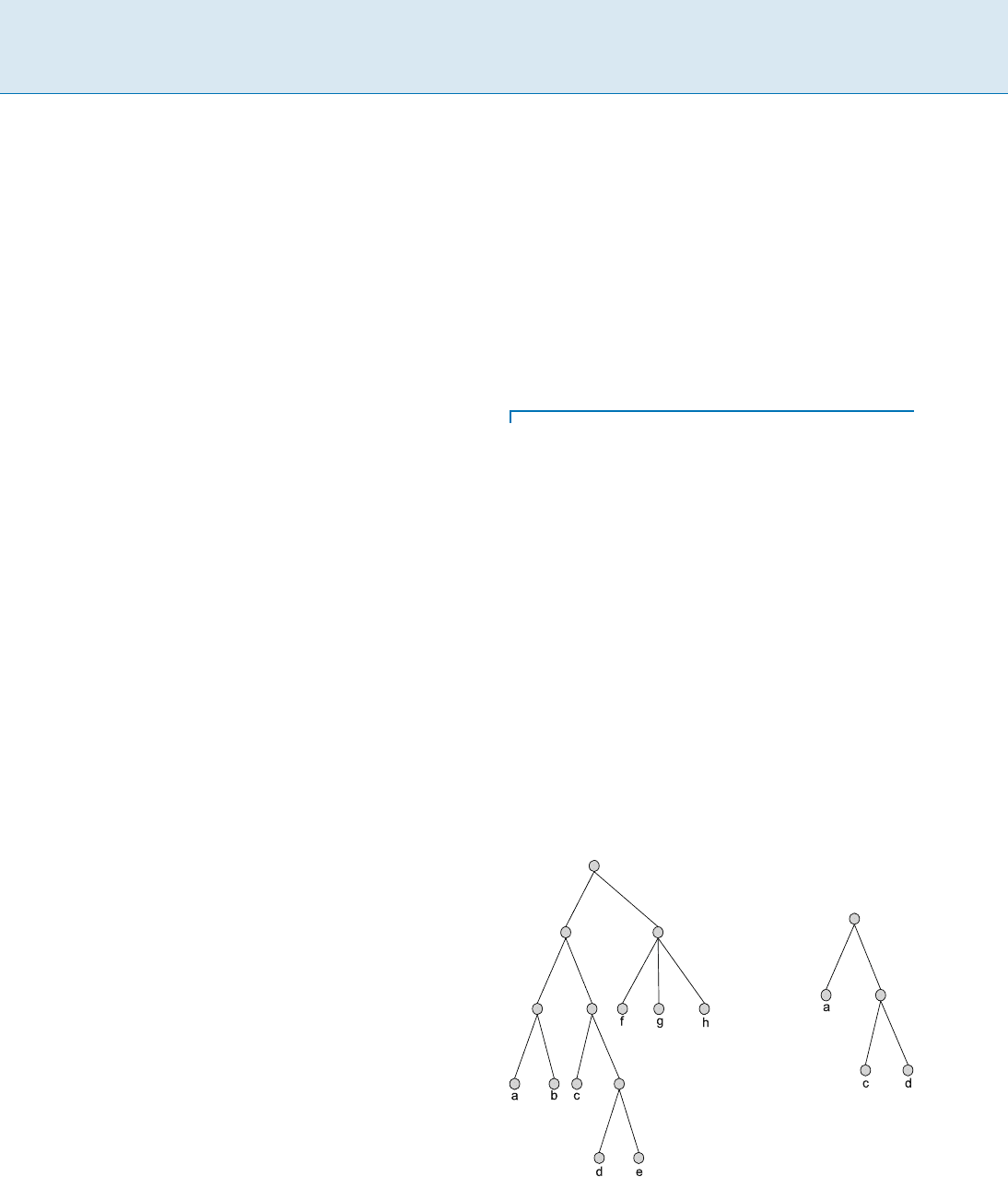Kao M.-Y. (ed.) Encyclopedia of Algorithms
Подождите немного. Документ загружается.


488 M Market Games and Content Distribution
Applications
The growth of the Internet, the World Wide Web, and
wide-area wireless networks allow an increasing number
of users to access vast amounts of information in different
geographic areas. As one of the most important functions
of the service provider, content delivery can be performed
by caching popular items in cache locations close to the
users. Performing such a task in a decentralized manner in
the presence of self-interested entities in the system can be
modeled as an uncoordinated two-sided market game.
The 3G subscriber market can be categorized into
groups with shared interest in location-based services,
e. g., the preview of movies in a theater or scenes of the
mountain nearby. Since the 3G radio resources are lim-
ited, it is expensive to repeatedly transmit large quantities
of data over the air interface from the base station (BS).
It is more economical for the service provider to offload
such repeated requests on to the ad-hoc network com-
prised of its subscribers where some of them recently ac-
quired a copy of the data. In this scenario, the goal for the
service provider is to give incentives for peer subscribers in
the system to cache and forward the data to the requesting
subscribers. Since each data item is large in size and tran-
sit subscribers are mobile, we assume that the data transfer
occurs in a close range of a few hops.
In this setting, envision a system consisting of two
groups of subscribers: resident and transit subscribers.
Resident subscribers are less mobile and mostly confined
to a certain geographical area. Resident subscribers have
incentives to cache data items that are specific to this geo-
graphical region since the service provider gives monetary
rewards for satisfying the queries of transit subscribers.
Transit subscribers request their favorite data items when
they visit a particular region. Since the service provider
does not have knowledge of the spatial and temporal dis-
tribution of requests, it is difficult if not impossible for
the provider to stipulate which subscriber should cache
which set of data items. Therefore, the decision of what
to cache is left to each individual subscriber. The realiza-
tion of this content distribution system depends on two
main issues. First, since subscribers are selfish agents, they
may act to increase their individual payoff and decrease
the performance of the system. Here, we provide a frame-
work for which we can prove that in an equilibrium sit-
uation of this framework, we use the performance of the
system efficiently. The second issue is that the payoff of
each request for each agent must be a function of the set of
agents that have this request in their strategy, since these
agents compete on this request and the profit of this re-
quest should be divided among these agents in an appro-
priate way. Therefore, each selfish agent may change the
set of items it cached in response to the set of items cached
by others. This model leads to a non-cooperative caching
scenario that can be modeled on a two-sided market game,
studied and motivated in the context of market sharing
games and distributed caching games [4,6,11].
Open Problems
It is known that there exist instances of the distributed
caching game with no pure Nash equilibria. It is also
known that best response dynamics of players may take ex-
ponential time to converge to pure Nash equilibria. An in-
teresting question is to study the performance of sink equi-
libria [7,11] or the price of sinking [7,11] for these games.
The distributed caching game is a valid-utility game. Goe-
mans, Mirrokni, and Vetta [7] show that despite the price
of anarchy of
1
2
for valid-utility games, the performance
of sink equilibria (or price of sinking) for these games is
1
n
. We conjecture that the price of sinking for DCP games
is a constant. Moreover, it is interesting to show that af-
ter polynomial rounds of best responses of players the ap-
proximation factor of the solution is a constant. We know
that one round of best responses of players is not suffi-
cient to get constant-factor solutions. It might be easier to
show that after a polynomial number of random best re-
sponses of players, the expected total profit of players is at
least a constant factor of the optimal solution. Similar pos-
itive results for sink equilibria and random best responses
of players are known for congestion games [7,11].
The complexity of verifying if a given state of the dis-
tributed caching game is in a sink equilibrium or not is an
interesting question to explore. Also, given a distributed
caching game (or a many-to-one two-sided market game),
an interesting problem is to check if the set of all sink
equilibria is pure Nash equilibria or not. Finally, an in-
teresting direction of research is to classify classes of two-
sided market games for which pure Nash equilibria exists
or best-response dynamics of players converge to a pure
Nash equilibrium.
Cross References
Stable Marriage
Stable Marriage with Ties and Incomplete Lists
Best Response Algorithms for Selfish Routing
Recommended Reading
1. Ackermann,H.,Goldberg,P.,Mirrokni,V.,Röglin,H.,Vöck-
ing, B.: A unified Approach to Congestion Games and Two-
sided markets. In: 3rd Workshop of Internet Economics (WINE),
pp. 30–41. San Diego, CA, USA (2007)

Max Cut M 489
2. Ackermann, H., Goldberg, P., Mirrokni, V., Röglin, H., Vöcking,
B.: Uncoordinated two-sided markets. ACM Electronic Com-
merce (ACM EC) (2008)
3. Chekuri, C., Khanna, S.: A PTAS for the multiple knapsack prob-
lem. In 11th ACM-SIAM Symp. on Discrete Algorithms (SODA),
pp. 213–222 (2000)
4. Fleischer, L., Goemans, M., Mirrokni, V.S., Sviridenko, M.: Tight
approximation algorithms for maximum general assignment
problems. In: Proceedings of the 16th Annual ACM–SIAM Sym-
posium on Discrete Algorithms (SODA), pp. 611–620 (2006)
5. Gale, D., Shapley, L.: College admissions and the stability of
marriage. Am. Math. Mon. 69, 9–15 (1962)
6. Goemans, M., Li, L., Mirrokni, V.S., Thottan, M.: Market sharing
games applied to content distribution in ad-hoc networks. In:
Proceedings of the 5th ACM International Symposium on Mo-
bile Ad Hoc Networking and Computing (MobiHoc), pp. 1020–
1033 (2004)
7. Goemans, M., Mirrokni, V.S., Vetta, A.: Sink equilibria and con-
vergence. In: 46th Conference on Foundations of Computer
Science (FOCS), pp. 123–131 (2005)
8. Johnson, D., Papadimitriou, C.H., Yannakakis, M.: How easy is
local search? J. Comp. Syst. Sci. 37, 79–100 (1988)
9. Knuth, D.: Marriage Stables et leurs relations avec d’autres
problèmes Combinatories. Les Presses de l’Université de Mon-
tréal (1976)
10. Kojima, F., Unver, Ü.: Random paths to pairwise stability in
many-to-many matching problems: A study on market equi-
libration. Intern. J. Game Theor. (2006)
11. Mirrokni, V.S.: Approximation Algorithms for Distributed and
Selfish Agents. Ph.D. thesis, Massachusetts Institute of Tech-
nology (2005)
12. Nash, J.F.: Non-cooperative games. Ann. Math. 54, 268–295
(1951)
13. Papadimitriou, C.H., Schaffer, A., Yannakakis, M.: On the com-
plexity of local search. In: 22nd Symp. on Theory of Computing
(STOC), pp. 438 – 445 (1990)
14. Roth, A.E., Vande Vate, J.H.: Random paths to stability in two-
sided matching. Econometrica 58(6), 1475–1480 (1990)
15. Schaffer, A. Yannakakis, M.: Simple local search problems that
are hard to solve. SIAM J. Comput. 20(1), 56–87 (1991)
16. Vetta, A.: Nash equilibria in competitive societies, with applica-
tions to facility location, traffic routing and auctions. In: 43rd
Symp. on Foundations of Computer Science (FOCS), pp. 416–
425 (2002)
Max Cut
1994; Goemans, Williamson
1995; Goemans, Williamson
ALANTHA NEWMAN
Department of Algorithms and Complexity,
Max-Planck Institute for Computer Science,
Saarbrücken, Germany
Keywords and Synonyms
Maximum bipartite subgraph
Problem Definition
Given an undirected edge-weighted graph, G =(V; E), the
maximum cut problem (M
AX-CUT)istofindabipar-
tition of the vertices that maximizes the weight of the
edges crossing the partition. If the edge weights are non-
negative, then this problem is equivalent to finding a maxi-
mum weight subset of the edges that forms a bipartite sub-
graph, i. e. the maximum bipartite subgraph problem. All
results discussed in this article assume non-negative edge
weights. M
AX-CUT is one of Karp’s original NP-complete
problems [19]. In fact, it is NP-hard to approximate to
within a factor better than 16/17[16,33].
For nearly twenty years, the best-known approxima-
tion factor for M
AX-CUT was half, which can be achieved
by a very simple algorithm: Form a set S by placing each
vertex in S with probability half. Since each edge crosses
the cut (S; V n S) with probability half, the expected value
of this cut is half the total edge weight. This implies that for
any graph, there exists a cut with value at least half of the
total edge weight. In 1976, Sahni and Gonzalez presented
a deterministic half-approximation algorithm for M
AX-
C
UT, which is essentially a de-randomization of the afore-
mentioned randomized algorithm [31]: Iterate through
the vertices and form sets S and
¯
S by placing each vertex
in the set that maximizes the weight of cut (S;
¯
S)thusfar.
After each iteration of this process, the weight of this cut
will be at least half of the weight of the edges with both
endpoints in S [
¯
S.
This simple half-approximation algorithm uses the
fact that for any graph with non-negative edge weights, the
total edge weight of a given graph is an upper bound on
the value of its maximum cut. There exist classes of graphs
for which a maximum cut is arbitrarily close to half the
total edge weight, i. e. graphs for which this “trivial” upper
bound can be close to twice the true value of an optimal so-
lution. An example of such a class of graphs are complete
graphs on n vertices, K
n
. In order to obtain an approxima-
tion factor better than half, one must be able to compute
an upper bound on the value of a maximum cut that is
better, i. e. smaller, than the trivial upper bound for such
classes of graphs.
Linear Programming Relaxations
For many optimization (maximization) problems, linear
programming has been shown to yield better (upper)
bounds on the value of an optimal solution than can be ob-
tained via combinatorial methods. There are several well-
studied linear programming relaxations for M
AX-CUT.
For example, a classical integer program has a variable x
e
for each edge and a constraint for each odd cycle, requir-

490 M Max Cut
ing that an odd cycle C contribute at most jCj1edgesto
an optimal solution.
max
X
e2E
w
e
x
e
X
e2C
x
e
jCj1 8 odd cycles C
x
e
2f0; 1g :
The last constraint can be relaxed so that each x
e
is re-
quired to lie between 0 and 1, but need not be integral, i. e.
0 x
e
1. Although this relaxation may have exponen-
tially many constraints, there is a polynomial-time separa-
tion oracle (equivalent to finding a minimum weight odd-
cycle), and thus, the relaxation can be solved in polyno-
mial time [13]. Another classical integer program contains
avariablex
ij
for each pair of vertices. In any partition of
the vertices, either zero or two edges from a 3-cycle cross
the cut. This requirement is enforced in the following in-
teger program. If edge (i; j) … E,thenw
ij
is set to 0.
max
X
i;j2V
w
ij
x
ij
x
ij
+ x
jk
+ x
ki
2 8i; j; k 2 V
x
ij
+ x
jk
x
ki
0 8i; j; k 2 V
x
ij
2f0; 1g :
Again, the last constraint can be relaxed so that each x
ij
is
required to lie between 0 and 1. In contrast to the afore-
mentioned cycle-constraint based linear program, this lin-
ear programming relaxation has a polynomial number of
constraints.
Both of these relaxations actually have the same opti-
mal value for any graph with non-negative edge weights [3,
26,30]. (For a simplified proof of this, see [25].) Poljak
showed that the integrality gap for each of these relax-
ations is arbitrarily close to 2 [26]. In other words, there
are classes of graphs that have a maximum cut containing
close to half of the edges, but for which each of the above
relaxations yields an upper bound close to all the edges,
i. e. no better than the trivial “all-edges” bound. In partic-
ular, graphs with a maximum cut close to half the edges
and with high girth can be used to demonstrate this gap.
A comprehensive look at these linear programming relax-
ations is contained in the survey of Poljak and Tuza [30].
Eigenvalue Upper Bounds
Delorme and Poljak [7] presented an eigenvalue up-
per bound on the value of a maximum cut, which was
a strengthened version of a previous eigenvalue bound
considered by Mohar and Poljak [24]. Computing De-
lorme and Poljak’s upper bound is equivalent to solving an
eigenvalue minimization problem. They showed that their
bound is computable in polynomial time with arbitrary
precision. In a series of work, Delorme, Poljak and Rendl
showed that this upper bound behaves “differently” from
the linear-programming-based upper bounds. For exam-
ple, they studied classes of sparse random graphs (e. g.
G(n, p)withp = 50/n) and showed that their upper bound
is close to optimal on these graphs [8]. Since graphs of this
type can also be used to demonstrate an integrality gap ar-
bitrarily close to 2 for the aforementioned linear program-
ming relaxations, their work highlighted contrasting be-
havior between these two upper bounds. Further compu-
tational experiments on other classes of graphs gave more
evidence that the bound was indeed stronger than previ-
ously studied bounds [27,29]. Delorme and Poljak conjec-
tured that the 5-cycle demonstrated the worst-case behav-
ior for their bound: a ratio of 32/(25 + 5
p
5) :88445 be-
tween their bound and the optimal integral solution. How-
ever, they could not prove that their bound was strictly less
than twice the value of a maximum cut in the worst case.
Key Results
In 1994, Goemans and Williamson presented a ran-
domized .87856-approximation algorithm for M
AX-
C
UT [11]. Their breakthrough work was based on round-
ing a semidefinite programming relaxation and was the
first use of semidefinite programming in approximation
algorithms. Poljak and Rendl showed that the upper
bound provided by this semidefinite relaxation is equiv-
alent to the eigenvalue bound of Delorme and Poljak [28].
Thus, Goemans and Williamson’s proved that the eigen-
value bound of Delorme and Poljak is no more than 1.138
times the value of a maximum cut.
A Semidefinite Relaxation
M
AX-CUT can be formulated as the following quadratic
integer program, which is NP-hard to solve. Each vertex
i 2 V is represented by a variable y
i
, which is assigned ei-
ther 1 or 1 depending on which side of the cut it occu-
pies.
max
1
2
X
(i; j)2E
w
ij
(1 y
i
y
j
)
y
i
2f1; 1g8i 2 V :
Goemans and Williamson considered the following relax-
ation of this integer program, in which each vertex is rep-

Max Cut M 491
resented by a unit vector.
max
1
2
X
(i; j)2E
w
ij
(1 v
i
v
j
)
v
i
v
i
=1 8i 2 V
v
i
2 R
n
8i 2 V :
They showed that this relaxation is equivalent to
a semidefinite program. Specifically, consider the follow-
ing semidefinite relaxation:
max
1
2
X
(i; j)2E
w
ij
(1 y
ij
)
y
ii
=1 8i 2 V
Y positive semidefinite :
The equivalence of these two relaxations is due to the fact
that a matrix Y is positive semidefinite if and only if there
is a matrix B such that B
T
B = Y. The latter relaxation
can be solved to within arbitrary precision in polynomial
time via the Ellipsoid Algorithm, since it has a polyno-
mial-time separation oracle [14]. Thus, a solution to the
first relaxation can be obtained by finding a solution to
the second relaxation and finding a matrix B such that
B
T
B = Y.IfthecolumnsofB correspond to the vectors
fv
i
g,theny
ij
= v
i
v
j
, yielding a solution to the first re-
laxation.
Random-Hyperplane Rounding
Goemans and Williamson showed how to round the
semidefinite programming relaxation of M
AX-CUT using
a new technique that has since become known as “ran-
dom-hyperplane rounding” [11]. First obtain a solution
to the first relaxation, which consists of a set of unit vec-
tors fv
i
g, one vector for each vertex. Then choose a ran-
dom vector r 2
R
n
in which each coordinate of r is cho-
sen from the standard normal distribution. Finally, set
S = fijv
i
r 0g andoutputthecut(S; V n S).
The probability that a particular edge (i; j) 2 E crosses
the cut is equal to the probability that the dot products
v
i
r and v
j
r differ in sign. This probability is exactly
equal to
ij
/,where
ij
is the angle between vectors v
i
and v
j
. Thus, the expected weight of edges crossing the cut
is equal to
P
(i; j)2E
ij
/. How large is this compared to
the objective value given by the semidefinite programming
relaxation, i. e. what is the approximation ratio?
Define ˛
gw
as the worst-case ratio of the expected con-
tribution of an edge to the cut, to its contribution to the
objective function of the semidefinite programming relax-
ation. In other words: ˛
gw
=min
0
2
1cos
.Itcan
be shown that ˛
gw
>:87856. Thus, the expected value of
a cut is at least ˛
gw
SDP
OPT
, resulting in an approxima-
tion ratio of at least .87856 for M
AX-CUT. The same anal-
ysis applies to weighted graphs with non-negative edge
weights.
This algorithm was de-randomized by Mahajan and
Hariharan [23]. Goemans and Williamson also applied
their random-hyperplane rounding techniques to give im-
proved approximation guarantees for other problems such
as M
AX-DICUT and MAX-2SAT.
Integrality Gap and Hardness
Karloff showed that there exist graphs for which the best
hyperplane is only a factor ˛
gw
of the maximum cut [18],
showing that there are graphs for which the analysis in [11]
is tight. Since the optimal SDP value for such graphs equals
the optimal value of a maximum cut, these graphs can not
be used to demonstrate an integrality gap. However, Feige
and Schechtman showed that there exist graphs for which
the maximum cut is a ˛
gw
fraction of the SDP bound [9],
thereby establishing that the approximation guarantee of
Goemans and Williamson’s algorithm matches the in-
tegrality gap of their semidefinite programming relax-
ation. Recently, Khot, Kindler, Mossel and O’Donnell [21]
showed that if the Unique Games Conjecture of Khot [20]
is assumed to be true, then it is NP-hard to approximate
M
AX-CUT to within any factor larger than ˛
gw
.
Applications
The work of Goemans and Williamson paved the way
for the further use of semidefinite programming in ap-
proximation algorithms, particularly for graph partition-
ing problems. Methods based on the random-hyperplane
technique have been successfully applied to many op-
timization problems that can be categorized as parti-
tion problems. A few examples are 3-C
OLORING [17],
M
AX-3-CUT [10,12,22], MAX-BISECTION [15], CORRE-
LATION-CLUSTERING [5,32], and SPARSEST-CUT [2]. Ad-
ditionally, some progress has been made in extending
semidefinite programming techniques outside the domain
of graph partitioning to problems such as B
ETWEEN-
NESS [6], BANDWIDTH [4], and LINEAR EQUATIONS
mod p [1].
Cross References
Graph Coloring
Maximum Two-Satisfiability
Sparsest Cut

492 M Maximum Agreement Subtree (of 2 Binary Trees)
Recommended Reading
1. Andersson, G., Engebretsen, L., Håstad, J.: A new way to use
semidefinite programming with applications to linear equa-
tions mod p.J.Algorithms39, 162–204 (2001)
2. Arora, S., Rao, S., Vazirani, U.: Expander flows, geometric em-
beddings and graph partitioning. In: Proceedings of the 36th
Annual Symposium on the Theory of Computing (STOC),
Chicago 2004, pp. 222–231
3. Barahona, F.: On cuts and matchings in planar graphs. Math.
Program. 60, 53–68 (1993)
4. Blum, A., Konjevod, G., Ravi, R., Vempala, S.: Semi-definite re-
laxations for minimum bandwidth and other vertex-ordering
problems. Theor. Comput. Sci. 235, 25–42 (2000)
5. Charikar, M., Guruswami, V., Wirth, A.: Clustering with qualita-
tive information. In: Proceedings of the 44th Annual IEEE Sym-
posium on Foundations of Computer Science (FOCS), Boston
2003, pp. 524–533
6. Chor, B., Sudan, M.: A geometric approach to betweeness.
SIAM J. Discret. Math. 11, 511–523 (1998)
7. Delorme, C., Poljak, S.: Laplacian eigenvalues and the maxi-
mum cut problem. Math. Program. 62, 557–574 (1993)
8.Delorme,C.,Poljak,S.:Theperformanceofaneigenvalue
bound in some classes of graphs. Discret. Math. 111, 145–156
(1993). Also appeared in: Proceedings of the Conference on
Combinatorics, Marseille, 1990
9. Feige, U., Schechtman, G.: On the optimality of the random
hyperplane rounding technique for MAX-CUT. Random Struct.
Algorithms 20(3), 403–440 (2002)
10. Frieze, A., Jerrum, M.R.: Improved approximation algorithms
for MAX-k-CUT and MAX BISECTION. Algorithmica 18, 61–77
(1997)
11. Goemans, M.X., Williamson, D.P.: Improved approximation al-
gorithms for maximum cut and satisfiability problems using
semidefinite programming. J. ACM 42, 1115–1145 (1995)
12. Goemans, M.X., Williamson, D.P.: Approximation algorithms for
MAX-3-CUT and other problems via complex semidefinite pro-
gramming. STOC 2001 Special Issue of J. Comput. Syst. Sci. 68,
442–470 (2004)
13. Grötschel, M., Lovász, L., Schrijver, A.: The ellipsoid method and
its consequences in combinatorial optimization. Combinator-
ica 1, 169–197 (1981)
14. Grötschel, M., Lovász, L., Schrijver, A.: Geometric Algorithms
and Combinatorial Optimization. Springer, Berlin (1988)
15. Halperin, E., Zwick, U.: A unified framework for obtaining
improved approximation algorithms for maximum graph bi-
section problems. Random Struct. Algorithms 20(3), 382–402
(2002)
16. Håstad, J.: Some optimal inapproximability results. J. ACM 48,
798–869 (2001)
17. Karger, D.R., Motwani, R., Sudan, M.: Improved graph color-
ing via semidefinite programming. J. ACM 45(2), 246–265
(1998)
18. Karloff, H.J.: How good is the Goemans-Williamson MAX CUT
algorithm? SIAM J. Comput. 29(1), 336–350 (1999)
19. Karp, R.M.: Reducibility Among Combinatorial Problems. In:
Complexity of Computer Computations, pp. 85–104. Plenum
Press, New York (1972)
20. Khot, S.: On the power of unique 2-prover 1-round games. In:
Proceedings of the 34th Annual Symposium on the Theory of
Computing (STOC), Montreal 2002, pp. 767–775
21. Khot, S., Kindler, G., Mossel, E., O’Donnell, R.: Optimal inapprox-
imability results for MAX CUT and other 2-variable CSPs? In:
Proceedings of the 45th Annual IEEE Symposium on Founda-
tions of Computer Science (FOCS), Rome 2004, pp. 146–154
22. de Klerk, E., Pasechnik, D., Warners, J.: On approximate graph
colouring and MAX-k-CUT algorithms based on the function.
J. Combin. Optim. 8(3), 267–294 (2004)
23. Mahajan, R., Hariharan, R.: Derandomizing semidefinite pro-
gramming based approximation algorithms. In: Proceedings
of the 36th Annual IEEE Symposium on Foundations of Com-
puter Science (FOCS), Milwaukee 1995, pp. 162–169
24. Mohar, B., Poljak, S.: Eigenvalues and the max-cut problem.
Czechoslov Math. J. 40(115), 343–352 (1990)
25. Newman, A.: A note on polyhedral relaxations for the maxi-
mum cut problem (2004). Unpublished manuscript
26. Poljak, S.: Polyhedral and eigenvalue approximations of the
max-cut problem. Sets, Graphs and Numbers. Colloqiua Math-
ematica Societatis Janos Bolyai 60, 569–581 (1992)
27. Poljak, S., Rendl, F.: Node and edge relaxations of the max-cut
problem. Comput. 52, 123–137 (1994)
28. Poljak, S., Rendl, F.: Nonpolyhedral relaxations of graph-bisec-
tion problems. SIAM J. Opt. 5, 467–487 (1995)
29. Poljak, S., Rendl, F.: Solving the max-cut using eigenvalues. Dis-
cret.Appl.Math.62(1–3), 249–278 (1995)
30. Poljak,S.,Tuza,Z.:Maximumcutsandlargebipartitesub-
graphs.DIMACSSer.Discret.Math.Theor.Comput.Sci.20,
181–244 (1995)
31. Sahni, S., Gonzalez, T.: P-complete approximation problems.
J. ACM 23(3), 555–565 (1976)
32. Swamy, C.: Correlation clustering: maximizing agreements via
semidefinite programming. In: Proceedings of 15th Annual
ACM-SIAM Symposium on Discrete Algorithms (SODA), New
Orleans 2004, pp. 526–527
33. Trevisan,L.,Sorkin,G.,Sudan,M.,Williamson,D.:Gadgets,ap-
proximation, and linear programming. SIAM J. Comput. 29(6),
2074–2097 (2000)
Maximum Agreement Subtree
(of 2 Binary Trees)
1996; Cole, Hariharan
RAMESH HARIHARAN
Strand Life Sciences, Bangalore, India
Keywords and Synonyms
Isomorphism; Tree agreement
Problem Definition
Consider two rooted trees T
1
and T
2
with n leaves each.
The internal nodes of each tree have at least two children
each. The leaves in each tree are labeled with the same
set of labels and further, no label occurs more than once

Maximum Agreement Subtree (of 2 Binary Trees) M 493
in a particular tree. An agreement subtree of T
1
and T
2
is defined as follows. Let L
1
be a subset of the leaves of
T
1
and let L
2
be the subset of those leaves of T
2
which
have the same labels as leaves in L
1
.ThesubtreeofT
1
in-
duced by L
1
is an agreement subtree of T
1
and T
2
if and
only if it is isomorphic to the subtree of T
2
induced by L
2
.
The Maximum Agreement Subtree problem (henceforth
called MAST) asks for the largest agreement subtree of T
1
and T
2
.
The terms induced subtree and isomorphism used
above need to be defined. Intuitively, the subtree of T in-
duced by a subset L of the leaves of T is the topological
subtree of T restricted to the leaves in L, with branching in-
formation relevant to L preserved. More formally, for any
two leaves abof a tree T,letlca
T
(a; b)denotetheirlowest
common ancestor in T.Ifa = b,lca
T
(a; b)=a.Thesub-
tree U of Tinducedby a subset L of the leaves is the tree
with leaf set L and interior node set flca
T
(a; b)ja; b 2 Lg
inheriting the ancestor relation from T,thatis,forall
a; b 2 L,lca
U
(a; b)=lca
T
(a; b).
Intuitively, two trees are isomorphic if the children of
each node in one of the trees can be reordered so that
the leaf labels in each tree occur in the same order and
the shapes of the two trees become identical. Formally,
two trees U
1
and U
2
with the same leaf labels are said
to be isomorphic if there is a 1–1 mapping between
their nodes mapping leaves to leaves with the same la-
bels and such that for any two different leaves ab of U
1
,
(lca
U
1
(a; b)) = lca
U
2
((a);(b)).
Key Results
Previous Work
Finden and Gordon [8] gave a heuristic algorithm for
the MAST problem on binary trees which had an O(n
5
)
running time and did not guarantee an optimal so-
lution.Kubicka,KubickiandMcMorris[13]gavean
O(n
(:5+)logn
) algorithm for the same problem. The first
polynomial time algorithm for this problem was given
by Steel and Warnow [15]; it had a running time of
O(n
2
). Steel and Warnow also considered the case of
non-binary and unrooted trees. Their algorithm takes
O(n
2
) time for fixed degree rooted and unrooted trees
and O(n
4:5
log n) for arbitrary degree rooted and un-
rooted trees. They also give a linear reduction from the
rooted to the unrooted case. Farach and Thorup gave an
O(nc
p
log n
) time algorithm for the MAST problem on bi-
nary trees; here c is a constant greater than 1. For arbi-
trary degree trees, their algorithm takes O(n
2
c
p
log n
)time
for the unrooted case [6]andO(n
1:5
log n)timeforthe
rooted case [7]. Farach, Przytycka, and Thorup [4]ob-
tained an O(n log
3
n) algorithm for the MAST problem
on binary trees. Kao [12] obtained an algorithm for the
same problem which takes O(n log
2
n) time. This algo-
rithm takes O(minfnd
2
log d log
2
n; nd
3
2
log
3
ng)forde-
gree d trees.
The MAST problem for more than two trees has also
been studied. Amir and Keselman [1] showed that the
problem is NP-hard for even 3 unbounded degree trees.
However, polynomial bounds are known [1,5]forthreeor
more bounded degree trees.
Our Contribution
An O(n log n) algorithm for the MAST problem for two
binary trees is presented here. This algorithms is obtained
by improving upon the O(n log
3
n) algorithm from [4](in
fact, the final journal version [3] combines both papers).
The O(n log
3
n) algorithm of [4] can be viewed as tak-
ing the following approach (although the authors do not
describe it this way). It identifies two special cases and
then solves the general case by interpolating between these
cases.
Special Case 1: The internal nodes in both trees form
apath.TheMAST problem reduces to essentially a size n
Longest Increasing Subsequence Problem in this case. As
is well known, this can be solved in O(n log n)time.
Special Case 2: Both trees T
1
and T
2
are complete bi-
nary trees. For each node v in T
2
, only certain nodes u in
T
1
can be usefully mapped to v, in the sense that the sub-
tree of T
1
rooted at u and the subtree of T
2
rooted at v have
a non-empty Agreement Subtree. There are O(n log
2
n)
such pairs (u, v).Thiscanbeseenasfollows.Notethatfor
(u, v)tobesuchapair,thesubtreeofT
1
rooted at u and
the subtree of T
2
rooted at v must have a leaf-label in com-
mon. For each label, there are only O(log
2
n)suchpairs
obtained by pairing each ancestor of the leaf with this la-
bel in T
1
with each ancestor of the leaf with this label in T
2
.
The total number of interesting pairs is thus O(n log
2
n).
For each pair, computing the MAST takes O(1) time, as
it is simply a question of deciding the best way of pairing
their children.
The interpolation process takes a centroid decomposi-
tion of the two trees and compares pairs of centroid paths,
rather than individual nodes as in the complete tree case.
The comparison of a pair of centroid paths requires find-
ing matchings with special properties in appropriately de-
fined bipartite graphs, a non-trivial generalization of the
Longest Increasing Subsequence problem. This process

494 M Maximum Agreement Subtree (of 2 Binary Trees)
creates O(n log
2
n) interesting (u, v) pairs, each of which
takes O(log n) time to process.
This work provides two improvements, each of which
gains a log n factor.
Improvement 1: Thecompletetreespecialcaseisim-
proved to O(n log n) time as follows. A pair of nodes (u, v),
u 2 T
1
, v 2 T
2
,issaidtobeinteresting if there is an agree-
ment subtree mapping u to v.Asisshownbelow,forcom-
plete trees, the total number of interesting pairs (u, v)is
just O(n log n). Consider a node v in T
2
.LetL
2
be the set
of leaves which are descendants of v.LetL
1
be the set of
leaves in T
1
which have the same labels as the leaves in L
2
.
Theonlynodesthatmaybemappedtov are the nodes u
in the subtree of T
1
induced by L
1
.Thenumberofsuch
nodes u is O(size of the subtree of T
2
rooted at v). The to-
tal number of interesting pairs is thus the sum of the sizes
of all subtrees of T
2
,whichisO(n log n).
This reduces the number of interesting pairs (u, v)to
O(n log n). Again, processing a pair takes O(1) time (this
is less obvious, for identifying the descendants of u which
root the subtrees with which the two subtrees of v can be
matched is non-trivial). Constructing the above induced
subtree itself can be done in O(jL
1
j)time,aswillbede-
tailed later. The basic tool here is to preprocess trees T
1
and T
2
in O(n) time so that least common ancestor queries
can be answered in O(1) time.
Improvement 2: As in [4], when the trees are not com-
plete binary trees, the algorithm takes centroid paths and
matches pairs of centroid paths. The O(log n) cost that the
algorithm in [4] incurs in processing each such interest-
ing pair of paths arises when there are large (polynomial
in n size) instances of the generalized Longest Increasing
Subsequence Problem. At first sight, it is not clear that
large instances of these problems can be created for suf-
ficiently many of the interesting pairs; unfortunately, this
turns out to be the case. However, these problem instances
still have some useful structure. By using (static) weighted
trees, pairs of interesting vertices are processed in O(1)
time per pair, on the average, as is shown by an appro-
priately parametrized analysis.
TheMultipleDegreeCase
The techniques can be generalized to higher degree
bounds d > 2, by combining it with techniques from ([6,
Sect. 2]) for unbounded degrees. This appears to yield an
algorithm with running time O(minfn
p
d log
2
n; nd log n
log dg). The conjecture, however, is that there is an algo-
rithm with running time O(n
p
d log n).
Applications
Motivation
The MAST problem arises naturally in biology and lin-
guistics as a measure of consistency between two evolu-
tionary trees over species and languages, respectively. An
evolutionary tree for a set of taxa,eitherspeciesorlan-
guages, is a rooted tree whose leaves represent the taxa and
whose internal nodes represent ancestor information. It is
often difficult to determine the true phylogeny for a set of
taxa, and one way to gain confidence in a particular tree is
to have different lines of evidence supporting that tree. In
the biological taxa case, one may construct trees from dif-
ferent parts of the DNA of the species. These are known as
gene trees. For many reasons, these trees need not entirely
agree, and so one is left with the task of finding a consensus
of the various gene trees. The maximum agreement sub-
tree is one method of arriving at such a consensus. Notice
that a gene is usually a binary tree, since DNA replicates by
a binary branching process. Therefore, the case of binary
trees is of great interest.
Another application arises in automated translation
between two languages [10]. The two trees are the parse
trees for the same meaning sentences in the two lan-
guages. A complication that arises in this application (due
in part to imperfect dictionaries) is that words need not be
uniquely matched, i. e., a word at the leaf of one tree could
match a number (usually small) of words at the leaves of
the other tree. The aim is to find a maximum agreement
subtree; this is done with the goal of improving context-
using dictionaries for automated translation. So long as
each word in one tree has only a constant number of
matches in the other tree (possibly with differing weights),
the algorithm given here can be used and its performance
remains O(n log n). More generally, if there are m word
matches in all, the performance becomes O((m + n)logn).
Note however, that if there are two collections of equal
meaning words in the two trees of sizes k
1
and k
2
respec-
tively, they induce k
1
k
2
matches.
Cross References
Maximum Agreement Subtree (of 3 or More Trees)
Maximum Agreement Supertree
Recommended Reading
1. Amir, A., Keselman, D.: Maximum agreement subtree in a set of
evolutionary trees. SIAM J. Comput. 26(6), 1656–1669 (1997)
2. Cole, R., Hariharan, R.: An O(n log n) algorithm for the maxi-
mum agreement subtree problem for binary trees. Proc. of the
7th ACM-SIAM SODA, pp. 323–332 (1996)

Maximum Agreement Subtree (of 3 or More Trees) M 495
3. Cole, R., Farach-Colton, M., Hariharan, R., Przytycka, T., Tho-
rup, M.: An O(n log n) algorithm for the maximum agreement
subtree problem for binary trees. SIAM J. Comput. 30(5), 1385–
1404 (2000)
4. Farach, M., Przytycka, T., Thorup, M.: The maximum agreement
subtree problem for binary trees. Proc. of 2nd ESA (1995)
5.Farach,M.,Przytycka,T.,Thorup,M.:Agreementofmany
bounded degree evolutionary trees. Inf. Process. Lett. 55(6),
297–301 (1995)
6. Farach, M., Thorup, M.: Fast comparison of evolutionary trees.
Inf. Comput. 123(1), 29–37 (1995)
7. Farach, M., Thorup, M.: Sparse dynamic programming for
evolutionary-tree comparison. SIAMJ. Comput.26(1), 210–230
(1997)
8. Finden, C.R., Gordon, A.D.: Obtaining common pruned trees.
J. Classific. 2, 255–276 (1985)
9. Fredman, M.L.: Two applications of a probabilistic search tech-
nique: sorting X + Y and building balanced search trees. Proc.
of the 7th ACM STOC, pp. 240–244 (1975)
10. Grishman, R., Yangarber, R.: Private Communication. NYU
(1995)
11. Harel, D., Tarjan, R.E.: Fast algorithms for finding nearest com-
mon ancestors. SIAM J. Comput. 13(2), 338–355 (1984)
12. Kao, M.-Y.: Tree contractions and evolutionary trees. SIAM J.
Comput. 27(6), 1592–1616 (1998)
13. Kubicka, E., Kubicki, G., McMorris, F.R.: An algorithm to find
agreement subtrees. J. Classific. 12, 91–100 (1995)
14. Mehlhorn, K.: A best possible bound for the weighted path
length of binary search trees. SIAM J. Comput. 6(2), 235–239
(1977)
15. Steel, M., Warnow, T.: Kaikoura tree theorems: computing the
maximum agreement subtree. Inf. Process. Lett. 48, 77–82
(1993)
Maximum Agreement Subtree
(of 3 or More Trees)
1995; Farach, Przytycka, Thorup
TERESA M. PRZYTYCKA
Computational Biology Branch, NCBI, NIH,
Bethesda, MD, USA
Keywords and Synonyms
Tree alignment
Problem Definition
The Maximum Agreement Subtree problem for k trees (k-
MAST) is a generalization of a similar problem for two
trees (MAST). Consider a tuple of k rooted leaf-labeled
trees (T
1
; T
2
:::T
k
). Let A = fa
1
; a
2
;:::a
n
g be the set of
leaf labels. Any subset B A uniquely determines the
so called topological restriction T|B of the three T to B.
Namely, T|B is the topological subtree of T spanned by
all leaves labeled with elements from B and lowest com-
mon ancestors of all pairs of these leaves. In particular,
the ancestor relation in T|B is defined so that it agrees
with the ancestor relation in T.AsubsetB of A such
T
1
jB;:::;T
k
jB are isomorphic is called an agreement set.
Problem 1 (k-MAST)
I
NPUT:Atuple
E
T =(T
1
;:::;T
k
) of leaf-labeled trees, with
a common set of labels A = fa
1
;:::;a
n
g,suchthatforeach
tree T
i
there exists one-to-one mapping between the set of
leaves of that tree and the set of labels A.
O
UTPUT:k-MAST(
E
T) equal to the maximum cardinality
agreement set of
E
T.
Key Results
In the general setting, k-MAST problem is NP-complete
for k 3[1]. Under the assumption that the degree of at
least one of the trees is bounded, Farach et al. proposed an
algorithm leading to the following theorem:
Theorem 1 If the degree of the trees in the tuple
E
T =
(T
1
;:::;T
k
) is bounded by d then the k-MAST(
E
T) can be
computed in O(kn
3
+ n
d
) time.
In what follows, the problem is restricted to finding the
cardinality of the maximum agreement set rather than the
set itself. The extension of this algorithm to an algorithm
that finds the agreement set (and subsequently the agree-
ment subtree) within the same time bounds is relatively
straightforward.
Recall that the classical O(n
2
) dynamic programming
algorithm for MAST of two binary trees [11] processes all
pairs of internal nodes of the two trees in a bottom up fash-
ion. For each pair of such nodes it computes the MAST
value for the subtrees rooted at this pair. There are O(n
2
)
pairs of nodes and the MAST value for the subtrees rooted
at a given pair of nodes can be computed in constant time
from MAST values of previously processed pairs of nodes.
Tosetthestageforthemoregeneralcase,letk-
MAST(
E
v) be the solution to the k-MAST problem for the
subtrees of T
1
(v
1
);:::;T
k
(v
k
)whereT
i
(v
i
)isthesubtree
if T
i
rooted at v
i
. If, for all i, u
i
is a strict ancestor of v
i
in
T
i
then,
E
v is dominated by
E
u (denoted
E
v
E
u).
A naive extension of the algorithm for two trees to
an algorithm for k trees would require computing k-
MAST(
E
v) for all possible tuples
E
v by processing these tu-
ples in the order consistent with the domination rela-
tion. The basic idea that allows to avoid ˝(n
k
)complex-
ity is to replace the computation of k-MAST(
E
v)withthe
computation of a related value, mast(
E
v), defined to be
the size of the maximum agreement set for the subtrees

496 M Maximum Agreement Subtree (of 3 or More Trees)
of (T
1
;:::;T
k
) rooted at (v
1
;:::v
k
) subject to the addi-
tional restriction that the agreement subtrees themselves
are rooted at v
1
;:::v
k
respectively. Clearly
k-MAST(T
1
;:::;T
k
)=max
Ev
mast(
E
v) :
The benefit of computing mast rather than k-MAST fol-
lows from the fact that most of mast values are zero and
it is possible to identify (very efficiently)
E
v with non-zero
mast values.
Remark 1 If mast(
E
v) > 0then
E
v =(lca
T
1
(a; b);:::
lca
T
k
(a; b)) for some leaf labels a, b where lca
T
i
(a; b)isthe
lowest common ancestor of leaves labeled by a and b in the
tree T
i
.
Atuple
E
v such that
E
v =(lca
T
1
(a; b);:::lca
T
k
(a; b)) for
some a; b 2 A is called an lca-tuple.ByRemark1itsuf-
fices to compute mast values for the lca-tuples only. Just
like in the naive approach, mast(
E
v)iscomputedfrommast
values of other lca-tuples dominated by
E
v.Anotherimpor-
tant observation is that only some lca-tuples dominated by
E
v are needed to compute mast(
E
v). To capture this, Farach
et al. define the so called proper domination relation (in-
troduced formally below) and show that the mast value for
any lca-tuple
E
v can be computed from mast values of lca-
tuples properly dominated by
E
v and that the proper domi-
nation relation has size O(n
3
).
Proper Domination Relation
Index the children of each internal node of any tree in
an arbitrary way. Given a pair
E
v;
E
w of lca-tuples such that
E
w
E
v the corresponding domination relation has asso-
ciated with it direction
E
ı
EwEv
=(ı
1
;:::;ı
k
)wherew
i
de-
scends from the child of v
i
indexed with ı
i
.Letv
i
(j)
be the child of v
i
with index j. The direction domi-
nation is termed active is if the subtrees rooted at the
v
1
(ı
1
);:::;v
k
(ı
k
) have at least one leaf label in common.
Note that each leaf label can witness only one active di-
rection, and consequently each lca-tuple can have at most
n active domination directions. Two directions
E
ı
EwEv
and
E
ı
EuEv
are called compatible if and only if the direction vec-
tors differ in all coordinates.
Definition 1
E
v properly denominates
E
u (denoted
E
u <
E
v)
if
E
v dominates
E
u along an active direction
E
ı and there ex-
ists another tuple
E
w which is also dominated by
E
v along an
active direction
E
ı
?
compatible with ı.
From the definition of proper domination and from the
fact that each leaf label can witness only one active domi-
nation direction, the following observations can be made:
Remark 2 The strong domination relation < on lca-tuples
has size O(n
3
). Furthermore, the relation can be computed
in O(kn
3
)time.
Remark 3 For any lca-tuple
E
v,ifmast(
E
v) > 0 then either
E
v is an lca-tuple composed of leaves with the same label or
E
v properly dominates some lca-tuple.
It remains to show how the values mast(
E
v)arecomputed.
For each lca-tuple
E
v, the so called compatibility graph G(
E
v)
is constructed. The nodes of G(
E
v) are active directions
from
E
v and there is an edge between two such nodes if and
only if corresponding directions are compatible. The ver-
tices of G(
E
v) are weighted and the weight of a vertex cor-
responding to an active direction
E
ı equals the maximum
mast value of a lca-tuple dominated by
E
v along the this di-
rection. Let MWC(G(
E
v)) be the maximum weight clique
in G(
E
v).
The bottom-up algorithm for computing non-zero
mast values based on the following recursive dependency
whose correctness follows immediately from the corre-
sponding definitions and Remark 3:
Lemma 2 For any lca-tuple
E
v
mast(
E
v)=max
(
1 if all elemets of
E
v are leaves
MWC(G(
E
v)) otherwise
: (1)
The final step is to demonstrate that once the lca-tuples
and the strong domination relation is pre-computed, the
computation all non-zero mast values can be preformed in
O(n
d
) time. This is done by generating all possible cliques
for all G(
E
v). Using the fact that the degree of at least one
tree is bounded by d one can show that all the cliques can
be generated in O(
P
ld
n
l
)=O(d
3
(ne/d)
d
)timeand
that there is O(d(ne/d)
d
)ofthem[6].
Applications
The k-MAST problem is motivated by the need to com-
pare evolutionary trees. Recent advances in experimental
techniques in molecular biology provide diverse data that
can be used to construct evolutionary trees. This diver-
sity of data combined with the diversity of methods used
to construct evolutionary trees often leads to the situa-
tion when the evolution of the same set of species is ex-
plained by different evolutionary trees. Maximum Agree-
ment Subtree problem has emerged as a measure of the
agreement between such trees and as a method to identify
subtree which is common for these trees. The problem was
first defined by Finden and Gordon in the context of two

Maximum Agreement Supertree M 497
binary trees [7]. These authors also gave a heuristic algo-
rithm to solve the problem. The O(n
2
)dynamicprogram-
ming algorithm for computing MAST values for two bi-
nary trees has been given in [11]. Subsequently, a number
of improvements leading to fast algorithms for computing
MAST value of two trees under various assumption about
rooting and tree degrees [5,10,8] and references therein.
The MAST problem for three or more unbounded de-
gree trees is NP-complete [1]. Amir and Keselman report
an O(kn
d+1
+ n
2d
) time algorithm for the agreement of
k bounded degree trees. The work described here provides
a O(kn
3
+ n
d
)forthecasewherethenumberoftreesisk
and the degree of at least one tree is bounded by d.For
d = 2 the complexity of the algorithm is dominated by the
first term. An O(kn
3
) algorithm for this case was also given
by Bryant [4]andO(n
2
log
k1
n) implementation of this
algorithm was proposed in [9].
k-MAST problem is fixed parameter tractable in p,
the smallest number of leafs labels such that removal of
the corresponding leaves produces agreement (see [3]and
references therein). Approximability of the MAST and
related problem has been studied in [2] and references
therein.
Cross References
Maximum Agreement Subtree (of 2 Binary Trees)
Maximum Agreement Supertree
Maximum Compatible Tree
Acknowledgments
This work was supported by the Intramural Research Program of the
National Instituts of Health, National Library of Medicine.
Recommended Reading
1. Amir, A., Keselman, D.: Maximum agreement subtree in a set
of evolutionary trees: Metrics and efficient algorithms. SIAM J.
Comput. 26(6), 1656–1669 (1997)
2. Berry,V.,Guillemot,S.,Nicolas,F.,Paul,C.:Ontheapproxima-
tion of computing evolutionary trees. In: COCOON, pp. 115–
125. (2005)
3. Berry, V., Nicolas, F.: Improved parameterized complexity of
the maximum agreement subtree and maximum compatible
tree problems. IEEE/ACM Trans. Comput. Biology Bioinform.
3(3), 289–302 (2006)
4. Bryand, D.: Building trees, hunting for trees, and comparing
trees: theory and methods in phylogenetic analysis. In: Ph. D.
thesis, Dept. Math., University of Canterbury (1997)
5. Cole, R., Farach-Colton, M., Hariharan, R., Przytycka, T., Thorup,
M.: An o(n logn) algorithm for the maximum agreement sub-
tree problem for binary trees. SIAM J. Comput., pp. 1385–1404.
(2001)
6. Farach,M.,Przytycka,T.M.,Thorup,M.:Ontheagreementof
many trees. Inf. Process. Lett. 55(6), 297–301 (1995)
7. Finden, C.R., Gordon, A.D.: Obtaining common pruned trees.
J. Classific. 2, 255–276 (1985)
8. Kao, M.-Y., Lam, T.-W., Sung, W.-K., Ting, H.-F.: An even faster
and more unifying algorithm for comparing trees via unbal-
anced bipartite matchings. J. Algorithms 40(2), 212–233 (2001)
9. Lee, C.-M., Hung, L.-J., Chang, M.-S., Tang, C.-Y.: An improved
algorithm for the maximum agreement subtree problem. BIBE,
p. 533 (2004)
10. Przytycka, T.M.: Transforming rooted agreement into unrooted
agreement. J. Comput. Biol. 5(2), 335–349 (1998)
11. Steel, M.A., Warnow, T.: Kaikoura tree theorems: Computing
the maximum agreement subtree. Inf. Process. Lett. 48(2), 77–
82 (1993)
Maximum Agreement Supertree
2005; Jansson, Ng, Sadakane, Sung
WING-KIN SUNG
Department of Computer Science, National University
of Singapore, Singapore, Singapore
Problem Definition
Let T be a tree whose leaves are distinctly labeled by a set
of taxa S. By distinctly labeled, we mean that no two leaves
in T have the same label. Given a subset S
0
of S, the topo-
logical restriction of T to S
0
(denoted by TjS
0
)isthetree
obtained by deleting from T all nodes which are not on
any path from the root to a leaf in S
0
along with their
incident edges, and then contracting every edge between
a node having just one child and its child (see Fig. 1). For
any tree T, denote its set of leaves by (T).
Maximum Agreement Supertree, Figure 1
Let T bethetreeontheleft.ThenTjfa; c; dg is the tree shown on
the right
